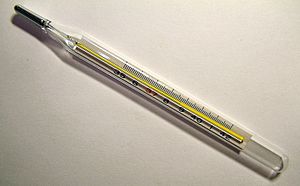Temperature measurement facts for kids
Temperature measurement, also called thermometry, is how we find out how hot or cold something is right now. We use this information for many reasons, like checking if you have a fever or making sure food is cooked just right. Scientists and engineers also use it to understand how the world works and to create new inventions.
Contents
How We Started Measuring Temperature
For a long time, people tried to measure how hot or cold things were, but it wasn't very accurate. Around 170 AD, a doctor named Galen tried to create a "neutral" temperature by mixing ice and boiling water.
The real science of measuring temperature began in the 1600s in Florence, Italy. Scientists like Galileo made early devices called thermoscopes. These could show if the temperature was changing, but they were also affected by air pressure.
The first sealed thermometer was built in 1654 by Ferdinand II, the Grand Duke of Tuscany. Then, in the early 1700s, Daniel Gabriel Fahrenheit created a mercury thermometer and a temperature scale that we still use today. Other important temperature scales are Celsius and Kelvin.
Tools for Measuring Temperature
Many different tools have been invented to measure temperature. Most of them work by measuring a physical change in a material as it gets hotter or colder.
One of the most common tools is the glass thermometer. This is a glass tube with a liquid inside, like mercury or colored alcohol. When the temperature goes up, the liquid expands and moves higher in the tube. You can then read the temperature from the marks on the glass.
Other important tools for measuring temperature include:
- Thermocouples: These use two different metals joined together. When the junction gets hot, it creates a small electrical voltage that can be measured to find the temperature.
- Thermistors: These are resistors whose electrical resistance changes a lot with temperature.
- Resistance temperature detectors (RTDs): These also measure temperature by how their electrical resistance changes.
- Pyrometers: These measure very high temperatures from a distance, often by looking at the light an object gives off.
- Infrared thermometers: These measure temperature by detecting the infrared energy an object gives off. You often see these used to check people's temperatures without touching them.
When you measure temperature, it's important to make sure your measuring tool is actually the same temperature as the thing you're trying to measure. Sometimes, the tool itself can affect the temperature around it, giving you a slightly wrong reading.
Temperature and How We Feel
How warm or cold humans, animals, and plants feel isn't just about the number on a thermometer.
- Humidity in the air can make us feel hotter or colder because it affects how much sweat evaporates from our skin.
- The wind chill factor makes it feel colder on windy days, even if the thermometer shows the same temperature as a calm day. This is because wind takes heat away from our bodies faster.
Measuring Temperature Without Touching
In recent years, scientists have found ways to measure temperature without even touching the object. This is called non-invasive thermometry.
- In medicine, doctors can use special scans like MRI or CT scans to see the temperature inside body tissues without needing to put a sensor inside.
- In places like engines or flames, scientists use special laser techniques. These lasers can measure temperature very quickly and without disturbing what they are measuring.
See also
- Conversion of scales of temperature
- Color temperature
- Temperature data logger


